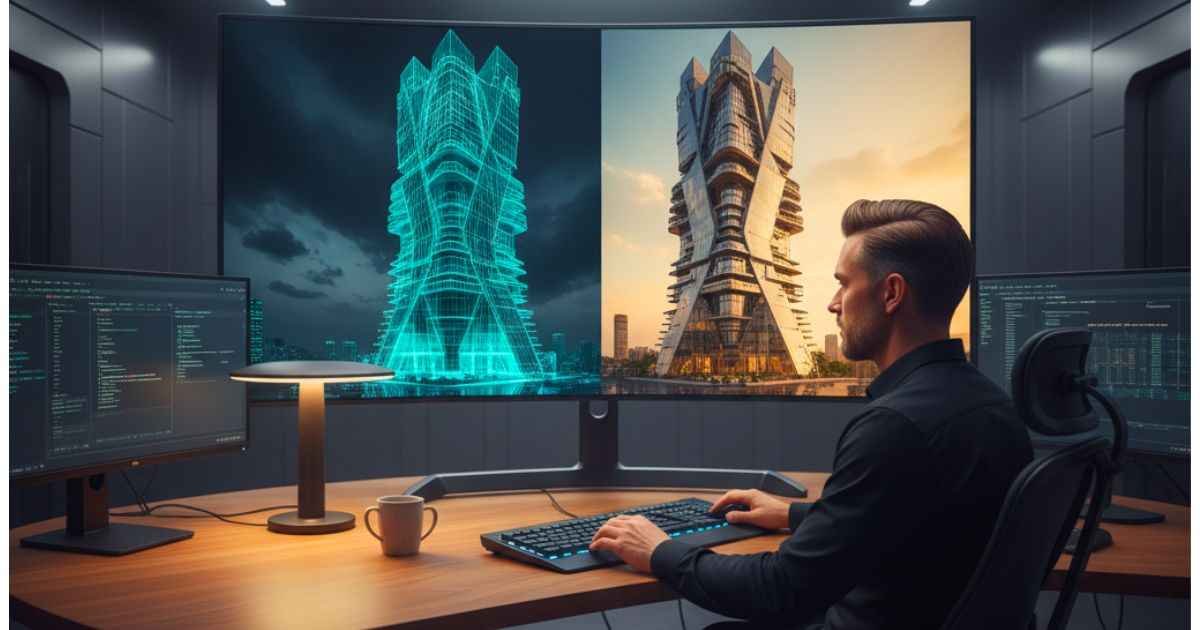Beyond Pretty Pictures
Let’s cut through the noise for a second.
You’re considering professional 3D rendering, but part of you wonders if it’s really worth the investment. Can’t the in-house designer figure it out? Wouldn’t stock photos do the trick? Maybe AI will just handle everything soon anyway?
Fair questions. Wrong conclusions.
Professional rendering delivers advantages that ripple far beyond nice-looking images. We’re talking measurable business impact – faster sales cycles, reduced costs, stronger client relationships, competitive edges that actually matter.
Seeing Before Building: The Revolution Nobody Talks About Enough
Imagine constructing an entire building, then realizing the lobby feels cramped and unwelcoming. Oops. That’s a million-dollar mistake right there.
Photorealistic visualization catches these issues when they’re still pixels on a screen rather than steel and concrete in the ground. Architects spot design flaws. Clients request changes without demolition crews. Stakeholders align on vision before breaking ground.
The construction industry alone saves billions annually through visualization-driven error prevention. One major developer reported that pre-construction rendering reduced change orders by 37% – changes that typically cost 5-10 times more during actual building phases.
Product designers face similar dynamics. Physical prototypes eat budgets and timelines. Want to test fifteen color variations? Traditional prototyping requires fifteen actual samples. Rendering? Fifteen files created in an afternoon.
As industrial designer Dieter Rams once said: “Good design is as little design as possible.” Professional rendering helps you find that minimalist perfection without wasteful iteration.
Marketing Materials That Actually Convert
Here’s something interesting: people process visual information 60,000 times faster than text.
Generic product photography doesn’t cut it anymore. Consumers expect contextual visualization – seeing items in realistic environments, from multiple angles, in various configurations. Traditional photography struggles with these demands economically.
Rendering sidesteps physical limitations entirely. Need your furniture collection shown in a modern loft, traditional home, and minimalist apartment? Done. Want impossible camera angles that showcase engineering details? Easy. Require seasonal variations showing products in summer and winter settings? No problem whatsoever.
Real estate marketing transformed completely. Properties sell from blueprints now. Buyers tour homes that exist only as plans and permits. Pre-sales funding entire developments before construction starts. This shift happened because rendering made it possible to sell dreams convincingly.
Industry statistics show that listings with 3D visualization receive 87% more views than traditional photography alone, and properties marketed with virtual tours sell approximately 31% faster on average.
Cost Efficiency That Sneaks Up On You
Professional rendering feels expensive upfront. Then you calculate alternatives.
Photography requires physical products, studio rental, equipment, talent, and countless reshoots when something’s not quite right. Location shoots add travel, permits, weather dependencies, and coordination headaches.
Compare that to rendering workflows. Create once, modify infinitely. Change colors instantaneously. Swap backgrounds effortlessly. Generate additional angles without new shoots. Updates happen in hours instead of weeks.
A furniture company I know about spent $45,000 annually on product photography. They switched to rendering and reduced costs by 60% while doubling their visual output. The math works surprisingly well once you factor in flexibility and reusability.
Consider lifecycle costs too. That photoshoot becomes obsolete when products change slightly. Rendered assets? Update the 3D model and re-render. Existing lighting, environment, and composition stay consistent automatically.
Speed to Market Advantages
Time is money, sure, but in competitive markets time becomes survival.
Traditional visualization methods operate on photography schedules – book studio time, arrange logistics, shoot, edit, review, possibly reshoot. Weeks disappear quickly. Product launches get delayed. Market opportunities slip away.
Rendering accelerates everything dramatically. Need campaign visuals for a product still in prototype stage? Rendering delivers while competitors wait for manufacturing. Want to test market reactions before committing to production? Show realistic visuals immediately.
Tech companies use this advantage ruthlessly. They gauge consumer interest with rendered concepts before investing in tooling and production. Poor response? Pivot quickly. Strong enthusiasm? Accelerate development confidently.
Partnering with experienced teams like Render Vision streamlines these timelines further – professionals who’ve solved similar challenges hundreds of times work faster and smarter than those figuring things out from scratch.
Consistency Across All Materials
Brand guidelines stress consistency. Photography makes consistency incredibly difficult.
Lighting changes between shoots. Colors shift across locations. Angles vary depending on photographer preference. Products look subtly different in every image, creating disjointed visual identities.
Rendering solves this elegantly. Establish lighting, materials, and camera settings once. Apply them uniformly across every visualization. Your product line maintains perfect visual harmony whether showing one item or one hundred.
This consistency extends internationally too. No need to ship physical products worldwide for regional marketing. Share 3D files globally, render locally or in cloud environments, maintain brand standards everywhere simultaneously.
Creative Flexibility Without Physical Constraints
Reality imposes limits. Gravity exists. Physics applies. Cameras can’t phase through walls.
Rendering ignores these inconveniences cheerfully.
Want to showcase internal mechanisms? Cut away exterior housing. Need to demonstrate assembly sequences? Show exploded views with floating components. Require impossible lighting that would melt physical products? Go wild digitally.
Automotive industry exploits this constantly – those commercials showing cars driving through impossible environments, with cameras swooping around and through vehicles? All rendered. Creating those shots practically would cost absurd money or simply be impossible.
The creative freedom manifests in subtle ways too:
- Perfect weather conditions every time
- Ideal time-of-day lighting regardless of actual schedule
- Flawless product condition without fingerprints or dust
- Dramatic angles that defy conventional photography
Author William Gibson noted that “The future is already here – it’s just not evenly distributed.” Professional rendering distributes that creative future to anyone willing to use it.
Client Communication Breakthrough
Miscommunication kills projects. Clients struggle articulating vision. Designers misinterpret vague descriptions. Revisions multiply. Frustration escalates.
Visualization short-circuits this dysfunction.
Show clients realistic renderings early in the process. Suddenly everyone discusses the same concrete thing rather than abstract concepts. “Make it more modern” becomes “adjust these specific elements.” Alignment happens faster with less friction.
Architecture firms report that clients approve designs 40% faster when presented with high-quality renderings versus traditional drawings and mood boards. That acceleration compounds across project timelines significantly.
Technical Documentation Enhancement
Engineering and technical teams benefit enormously too, though this advantage gets overlooked frequently.
Complex assemblies become comprehensible through cutaway renders and exploded views. Installation instructions gain clarity with step-by-step visualizations. Troubleshooting guides improve when showing realistic component identification.
Medical device manufacturers use rendering for regulatory documentation – showing device function and safety features with precision impossible in traditional photography. Aviation industry creates maintenance manuals with rendered diagrams identifying parts and procedures clearly.
According to manufacturing industry analysis, companies using 3D visualization in technical documentation report 52% fewer support calls and 28% faster technician training times.
Competitive Differentiation That Matters
Markets overflow with similar products marketed similarly. Standing out requires something extra.
Professional visualization quality signals professionalism, investment, and attention to detail. It suggests product quality before customers experience products directly. First impressions matter enormously in purchasing decisions.
Buyers increasingly expect sophisticated visual presentation. Meeting these expectations keeps you competitive. Exceeding them creates advantages. Ignoring them? That’s how you become invisible in crowded markets.
Environmental Considerations Worth Mentioning
Sustainability concerns influence business decisions increasingly.
Traditional photography generates waste – samples, packaging, shipping materials, studio resource consumption. Travel to location shoots produces carbon footprints. Physical prototypes for every design iteration add up environmentally.
Rendering dramatically reduces physical resource needs. Digital workflows minimize waste, energy consumption, and transportation requirements. It’s not perfectly green, but it’s considerably lighter environmentally than traditional alternatives.
The Integration Advantage
Modern rendering doesn’t exist in isolation – it integrates into broader digital ecosystems.
Models created for rendering serve multiple purposes: virtual reality experiences, augmented reality applications, configurators letting customers customize products, interactive presentations, and animation productions. Build once, deploy everywhere.
This integration multiplies return on investment. The 3D assets created for marketing renders become training tools, sales presentations, and customer engagement platforms. Smart companies leverage rendering investments across entire operations.
Making It Make Sense
Professional 3D rendering isn’t magic and it’s not charity. It’s a business tool delivering concrete advantages when applied appropriately.
The benefits compound over time. Initial investments in quality 3D assets pay dividends repeatedly. Capabilities expand as technology improves. Competitive advantages accumulate.
Sure, your nephew could probably muddle through Blender tutorials eventually. But while he’s learning, competitors are winning deals, launching products, and building brands with professional visualization.
The question isn’t whether professional rendering provides benefits. The question is whether you can afford ignoring those benefits while everyone else uses them.
Spoiler: you probably can’t.

I’m Emma Rose, the founder of tryhardguides.co.uk, and a content creator with a passion for writing across multiple niches—including health, lifestyle, tech, career, and personal development. I love turning complex ideas into relatable, easy-to-digest content that helps people learn, grow, and stay inspired. Whether I’m sharing practical tips or diving into thought-provoking topics, my goal is always to add real value and connect with readers on a deeper level.
Discover more from Try Hard Guides
Subscribe to get the latest posts sent to your email.

